 Sarajevo is the unique place in the world where in only few hours one can get immersed in the air of the city, ski at the nearby mountains or stroll along the rivers of Sarajevo.
Sarajevo is the unique place in the world where in only few hours one can get immersed in the air of the city, ski at the nearby mountains or stroll along the rivers of Sarajevo.
The city is surrounded with true Olympic mountains such as: Jahorina, Bjelasnica, Igman, Treskavica and Trebevic, 20-minute ride away from the down town and the winter-favourite places of the people in Sarajevo and the tourists world-wide.
Sarajevo as the capital of Bosnia and Herzegovina is one of the fastest growing cities in SE Europe. The city features a large number of business centres, cultural and educational institutions, while speleological, eco and spa tourism are only some forms of tourism that can be offered by this multicultural city.
As one of the most interesting and important municipalities in the Sarajevo Canton, certainly can be extracted Ilidža, situated at the foot of Igman mountain, featuring a major Antic structure (2,400 – 2,000 BC), proved by archaeological research to have been a structure originally built as a Spa for the Roman army. These thermal springs are now used for treating rheumatic and muscular disorders. Ilidža is the green oasis of Sarajevo, a place known as a cure for the body and soul (iladž – the person who heals) and the first inhabited place in the region of Sarajevo. Today, Ilidža owns a modern spa & recreational pool complex, hotels, numerous sports facilities, cycling and hiking routes.
North from Sarajevo there is the most fascinating speleological structure – Bijambarska cave. This cave contains three major caves open to public.
Sarajevo is also locally known as “the city on the river Miljacka”. The  river banks of Miljacka are bypassed by bridges from the period of Austro-Hungarian rule: Ajfel Bridge, Čobanija Bridge, Ćumurija Bridge, and modern-day bridges: Skenderija Bridge, Drvenija Bridge, Latinska Bridge, Suade and Olge Bridge, the Bridge of Malesian & Bosnian-Herzegovian Friendship. From the period of Ottoman rule there are the most ancient bridges in Sarajevo: the old Roman Bridge (close to Sarajevo), Kozija Bridge, Šeher-Ćehajina Bridge and Careva Bridge in the old part of the city. Some Sarajevo bridges are pedestrian only.
river banks of Miljacka are bypassed by bridges from the period of Austro-Hungarian rule: Ajfel Bridge, Čobanija Bridge, Ćumurija Bridge, and modern-day bridges: Skenderija Bridge, Drvenija Bridge, Latinska Bridge, Suade and Olge Bridge, the Bridge of Malesian & Bosnian-Herzegovian Friendship. From the period of Ottoman rule there are the most ancient bridges in Sarajevo: the old Roman Bridge (close to Sarajevo), Kozija Bridge, Šeher-Ćehajina Bridge and Careva Bridge in the old part of the city. Some Sarajevo bridges are pedestrian only.
Apart from the bridges, a part of Sarajevo is full of architectural structures from the Ottoman period among which there are numerous sub-dome mosques, residences, inns and domed market buildings.
In the vicinity of the city, there is the spring of the river Bosnia, with the popular picnic venue for the people of Sarajevo – Wellspring of the Bosnia. This natural monument is the most attractive spring of drinking water in Europe. Some 60 rocky springs in this area form the river Bosnia, lending its name to the country itself. The Wellspring was developed as a park as early as during Austro-Hungary. Its armlets and banks are bypassed by small bridges providing path crossings everywhere. The lane of plate-trees and oaks leads to a true natural paradise, brimming with brooks and ponds, crossed with small wooden bridges. It is a wonderful place to relax, especially if you reach the venue riding on a horse cab.
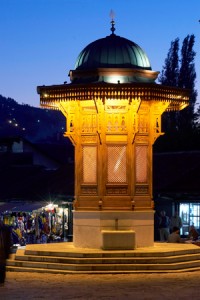 This city may brag its well-preserved old bazaar – Baščaršija, originating from the period of Ottoman rule over Bosnia and Herzegovina.
This city may brag its well-preserved old bazaar – Baščaršija, originating from the period of Ottoman rule over Bosnia and Herzegovina.
Baščaršija is Sarajevo’s old bazaar, historic and cultural centre of the city. It was built in mid-15th century by a Turkish governor Isa-bey Isaković, as is it widely held, at the same time as Sarajevo as the centre of the Ottoman rule.
The name of Baščaršija comes from the Turkish word “baş”, meaning the main and “çarşı” – meaning a part of town almost always the central part, therefore Baščaršija means the “main part of town” or “main town centre” or simply “down-town”. Baščaršija features a few important historic structures such as Gazi Husrev-Bey Mosque and Clock-Tower, and today’s Baščaršija is the main tourist attraction in Sarajevo.
Baščaršija is known for a large number of crafts. In the second half of 16th century, there were 80 different crafts here. Baščaršija was divided by crafts so that each street featured shops for one or more kindred crafts (e.g. Blacksmiths, Tinkers, Saddlers streets). This period is known for series of market structures built such as domed market buildings, inns and caravanserais. The soul of Baščaršija lies in its shops. Today you can also find craftsmen trying to preserve the tradition and pass it along to new generations.
Every year, the city on the river Miljacka hosts a series of international  cultural festivals among which the major ones are: Sarajevo Film Festival (SFF), Sarajevo Jazz Festival, summer-time cultural festival “Baščaršija Nights”, theatrical festival of new productions “MESS”, “Sarajevo Winter” and “World’s Television Festival of Oriental Music”.
cultural festivals among which the major ones are: Sarajevo Film Festival (SFF), Sarajevo Jazz Festival, summer-time cultural festival “Baščaršija Nights”, theatrical festival of new productions “MESS”, “Sarajevo Winter” and “World’s Television Festival of Oriental Music”.
* Sarajevo is a city with one of the most ancient water supply systems in Europe. This system was built during the Ottoman rule by one of the major governors of Sarajevo – Gazi Husrev-Bey. It was a 7-km long and spread system, later on used as the basis for the modern water supply system.
* There is an ancient belief that whoever takes a sip from the fountain near Gazi Husrev-Bey Mosque will come back to Sarajevo.
* Sarajevo was the witness to the first power-driven tram in Europe. It was the first tram test-route from Vienna! The train was introduced soon after the Austro-Hungarian occupation.
* Sarajevo is the first socialist city to host the Olympic Games!
* Sarajevo won the gold medal for hospitality. Simply, it is the trait of the city.
SYMBOLS OF SARAJEVO
There are several historic facts for which Sarajevo is globally recognised. They are the symbols of Sarajevo:
 1. Four denominations at 50 sqm – Sarajevo is a meeting and crossing place of three monotheistic religions: Islam, Christianity and Judaism. It is the only city, apart from Jerusalem, where you can see a mosque, an Orthodox and a Catholic church and a synagogue close to one another.
1. Four denominations at 50 sqm – Sarajevo is a meeting and crossing place of three monotheistic religions: Islam, Christianity and Judaism. It is the only city, apart from Jerusalem, where you can see a mosque, an Orthodox and a Catholic church and a synagogue close to one another.
2. Assassination of Franz Ferdinand, heir to the throne of Austro-Hungary – A member of a secret organization Young Bosnia, Gavrilo Princip, assassinated the heir to the throne of Austro-Hungary, Franz Ferdinand and his wife Sophie on 28th June 1914. This assassination was the cause for the onslaught of the First World War. Today, at the corner of the street where the assassination took place there is the museum Sarajevo 1878 – 1918. The museum exhibits numerous artefacts from the period of Austro-Hungarian rule.
3. 14th Winter Olympic Games – In 1984, Sarajevo was elected host of the 14th Winter Olympic Games. The mountains of Jahorina, Bjelasnica, Igman and Trebevic and the hospitality of the people in Sarajevo made the Olympics unforgettable. This event gathered 49 countries and over a thousand participants.
4. War 1992 – 1995 – The modern period brought to the Balkans war conflicts and destruction of Sarajevo. Still, the spirit of Sarajevo was not destroyed under the siege. The spirit of resistance was shown by series of festivals, theatrical plays, exhibitions, music performances and literary meetings giving new hope and laying down the foundation for the future developments. The first classic theatrical plays in the city were held in Despic’s House so this structure may be considered as the predecessor of the modern theatre in Sarajevo. Today it houses the Museum of Literature and Dramatic Arts.
Interesting Facts about Sarajevo
What is Sarajevo famous for around the world, apart from the historic and cultural heritage, good food – above all the indispensable “Sarajevo kebab”, is also the national drink of the Bosnians and Herzegovians – coffee. Coffee was brought to the country by Ottomans, and the true Bosnian coffee (“kahva” or “kava”) is traditionally made and served in the special Turkish coffee pot (“džezva”) and demi-tass (“fildžan”).
Just how coffee is important for the Bosnians is also witnessed by the fact that they named types of coffee according to the occasions. Some are listed below:
Warm-Up Coffee – the first morning coffee;
Win-Wag Coffee – the later morning coffee sipped in a chit-chatting company;
Farewell Coffee – served at the end of socializing, later in the afternoon, as a polite gesture that it is time to go.
If the visitors coming to Sarajevo want to provide food for themselves rather  than have launch at local restaurants they can customarily try food at the local markets without the obligation of the “tasters” to buy any. There is a wide range of local cheese, dried meat and the sellers will be more than happy to commend the quality of their products. Bargaining goes too.
than have launch at local restaurants they can customarily try food at the local markets without the obligation of the “tasters” to buy any. There is a wide range of local cheese, dried meat and the sellers will be more than happy to commend the quality of their products. Bargaining goes too.
In Sarajevo, the city of rich history and new era filled with fun and joy, everything starts and ends with good food. After visiting this city you are sure to come back home with your stomach full and the T-shirt crying: “Kebabs! Kebabs! Kebabs!”






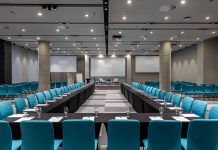
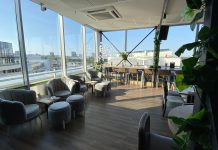













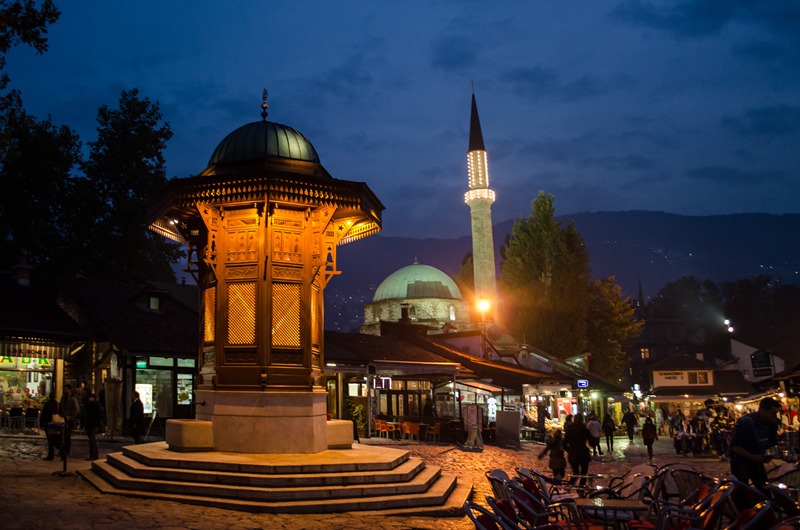


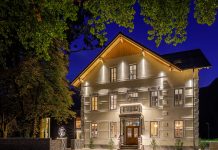

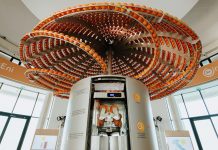












 Srpski
Srpski English
English